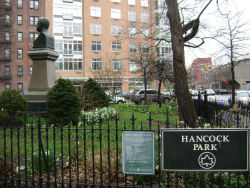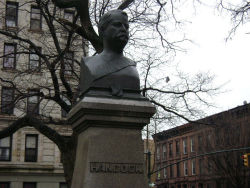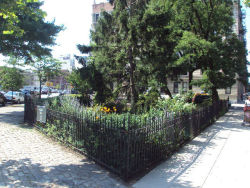Hancock Park
Hancock Park
This park is named for celebrated Civil War leader Winfield Scott Hancock (1824-1886). Hancock was born in Montgomery Square, Pennsylvania. Following his education at home, in the Norristown academy, and a public high school, young Winfield graduated from the U.S. Military Academy at West Point in 1844 at the age of twenty. He immediately entered military service, serving on the frontier, in the Mexican War, in the Seminole War, in Kansas during the border troubles, and in California. In 1861, Hancock requested to be returned east for active duty, and he was promoted to Brigadier General of volunteers by General-in-Chief of the Army George B. McClellan on September 23 of that year.
Hancock proved an outstanding leader in the Civil War. His performance at the battle of Williamsburg (1862) earned him the nickname “Hancock the Superb” and resulted in his promotion to Major General of volunteers. He commanded the first division of the second army corps at Fredericksburg (1862) and at Chancellorsville (1863). Hancock was severely wounded resisting Pickett’s charge at Gettysburg (1863). While pursuing General Robert E. Lee’s army through western Maryland, he assumed command of the second army corps. By March 1864 Hancock had recovered sufficiently to resume command and take part in assaults at the Wilderness, Spotsylvania, North Anna, Cold Harbor, and Petersburg. Due to the effects of his Gettysburg wound, he relinquished his command of the second army corps in June 1864. He was assigned several other command posts, including the Department of West Virginia, the Middle Military Division, and the Army of the Shenandoah.
General Hancock’s masterful performance in the war translated into distinction in peacetime. He was called to Washington D.C. in order to establish calm following the assassination of President Abraham Lincoln in April 1865. After his service as commander of the Department of the Missouri, he was transferred to the command of the Fifth Military District of Louisiana and Texas in 1867. From this post Hancock issued his “General Order No. 40,” which stated that the rights of the southern states were not being upheld in the reconstruction policy set forth by Congress. As a result of this order, when Hancock ran for President as the Democratic nominee in 1880, he carried the “solid south”; however, he lost the election by a narrow margin to James A. Garfield. General Hancock served as commander of the Military Department of the Atlantic from headquarters on Governors Island in New York from 1874 until he died there on February 9, 1886. His body was returned to Norristown, Pennsylvania for burial.
In 1886 the Board of Aldermen named the recently acquired property at Manhattan and St. Nicholas Avenues at 124th Street “Hancock Place.” James Wilson Alexander MacDonald (1824 – 1908), an accomplished sculptor of Civil War heroes, was commissioned to create a heroically-sized bronze portrait bust of General Hancock. MacDonald may have based the statue on a plaster mask he took of Hancock the year he ran for president. The statue’s torso is bare except for a wide sash across the left shoulder to signify military honor. It was fabricated in 1891 and dedicated on December 30, 1893.
The park was improved with new pavements, lawns, landscaping, and curbs in 1898-99. According to the 1929 Annual Report of the Department of Parks, subway construction in the late 1920s “totally destroyed” Hancock Park. The park was restored by 1936, at which time it included the statue, lawn, seven locust trees, and an iron picket fence.
Volunteers from the Coalition of 100 Black Women made early horticultural enhancements to the park starting in 1981. Further improvements made in 1998 and 1999 focused on the Hancock monument and plantings. The Citywide Monuments Conservation Program, a public - private partnership, maintain the portrait bust of General Hancock with regular cleanings and waxings. New plantings include evergreens, golden yellow tulip bulbs, lawn, groundcover, and a perennial garden.
Check out your park's Vital Signs
Clean & Safe
Green & Resilient
Empowered & Engaged Users
Share your feedback or learn more about how this park is part of a
Vital Park System



